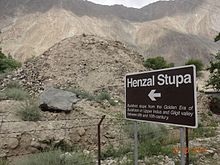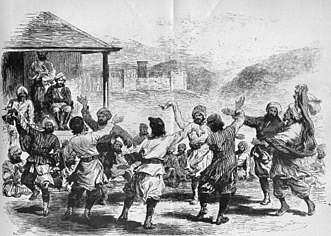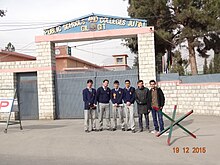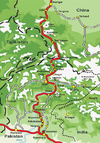User:Kazmi/test
This article includes a list of general references, but it lacks sufficient corresponding inline citations. (September 2016) |
Gilgit
گـلیت Gleet, Gilt, Geelt | |
|---|---|
City | |
 Gilgit is located in a valley | |
| Coordinates: 35°55′15″N 74°18′30″E / 35.92083°N 74.30833°E | |
| Country | |
| Autonomous state | G-B |
| District | Gilgit District |
| First mention | 3rd Century BC |
| Area | |
| • Total | 57 km2 (22 sq mi) |
| Elevation | 1,500 m (4,900 ft) |
| Population (1998) | |
| • Total | 216,760 |
| • Density | 3,800/km2 (9,800/sq mi) |
| Languages | |
| • Official | Urdu, Shina[2] |
| Time zone | UTC+5 (PST) |
| PIN | 1571 – 1xx[3] |
| Area code | +943 |
| Website | gilgit |
Gilgit (Shina: گلیت, Urdu:گلگت) is the capital city of Gilgit-Baltistan, an administrative territory of Pakistan. The city of Gilgit constitutes a tehsil within Gilgit District.[4] The city's ancient name was Sargin, later to be known as Gilit, and it is still referred to as Gilit or Sargin-Gilit by local people. In the Burushaski language, it is named Geelt and in Wakhi and Khowar it is called Gilt.
History
[edit]Buddhist era
[edit]Gilgit was an important city on the Silk Road, along which Buddhism was spread from South Asia to the rest of Asia. It is considered as a Buddhism corridor from which many Chinese monks came to Kashmir to learn and preach Buddhism.[5]
Brogpas trace their settlement from Gilgit into the fertile villages of Ladakh through a rich corpus of hymns, songs, and folklore that have been passed down through generations.[6] The Dards and Shinas appear in many of the old Pauranic lists of peoples who lived in the region, with the former also mentioned in Ptolemy's accounts[7] of the region. Two famous Chinese Buddhist pilgrims, Faxian and Xuanzang, traversed Gilgit according to their accounts.
According to Chinese records, between the 600s and the 700s, the city was governed by a Buddhist dynasty referred to as Little Balur or Lesser Bolü (Chinese: 小勃律).[8] They are believed to be the Patola Sahi dynasty, a devout adherent of early Vajrayana Buddhism.[9] During that time, the region was battled over by the Tang dynasty, Tibetan Empire, and the Abbasid Caliphate. In mid-600s, it was put under Chinese suzerainty after the fall of Western Turkic Khaganate due to Tang military campaigns in the region. In late 600s, the rising Tibetan Empire wrestled control of the region from the Chinese. However, faced with growing power of the Abbasid Empire to the west, the Tibetans had to ally with the Abbassid. The region was battled over by Chinese and Tibetan forces and their respective vassal states until the mid-700s. Chinese record of the region last until late-700s at which Tang's western military campaign was weakened due to An Lushan Rebellion.[10]
Pre-Trakhàn
[edit]
| “ | The former rulers had the title of Ra, and there is reason to suppose that they were at one time Hindus, but for the last five centuries and a half they have been Moslems. The names of the Hindu Ras have been lost, with the exception of the last of their number, Shri Buddutt. Tradition relates that he was killed by a Mohammedan adventurer, who married his daughter and founded a new dynasty, since called Trakhàn, from a celebrated Ra named Trakhan, who reigned about the commencement of the fourteenth century. The previous rulers—of whom Shri Buddutt was the last—were called Shahreis.[11] | ” |
Trakhàn Dynasty
[edit]
Gilgit was ruled for centuries by the local Trakhàn Dynasty, which ended about 1810 with the death of Raja Abas, the last Trakhàn Raja.[5] The rulers of Hunza and Nager also claim origin with the Trakhàn dynasty. They claim descent from a heroic Kayani Prince of Persia, Azur Jamshid (also known as Shamsher), who secretly married the daughter of the king Shri Badat. She conspired with him to overthrow her cannibal father. Sri Badat's faith is theorised as Hindu by some[12][13] and Buddhist by others.[14][15] However, considering the region's Buddhist heritage, with the most recent influence being Islam, the most likely preceding influence of the region is Buddhism. Though the Sanskrit titular Sri and the name Badat could denotes a Hindu origin of this ruler, adherents to Buddhism frequently employed Sankrit in the use of Buddhist texts.
Prince Azur Jamshid succeeded in overthrowing King Badat who was known as the Adam Khor (literally man-eater),[16][17] often demanding a child a day from his subjects, his demise is still celebrated to this very day by locals in traditional annual celebrations.[18] In the beginning of the new year, where a Juniper procession walks along the river, in memory of chasing the cannibal king Sri Badat away.[19]
Azur Jamshid abdicated after 16 years of rule in favour of his wife Nur Bakht Khatùn until their son and heir Garg, grew of age and assumed the title of Raja and ruled, for 55 years. The dynasty flourished under the name of the Kayani dynasty until 1421 when Raja Torra Khan assumed rulership. He ruled as a memorable king until 1475. He distinguished his family line from his step brother Shah Rais Khan (who fled to the king of Badakshan, and with whose help he gained Chitral from Raja Torra Khan), as the now-known dynastic name of Trakhàn. The descendants of Shah Rais Khan were known as the Ra'issiya Dynasty.[20]

1800s
[edit]| “ | The period of greatest prosperity was probably under the Shin Ras, whose rule seems to have been peaceable and settled. The whole population, from the Ra to the poorest subject lived by agriculture. According to tradition, Shri Buddutt's rule extended over Chitral, Yassin, Tangir, Darel, Chilas, Gor, Astor, Hunza, Nagar and Haramosh all of which were held by tributary princes of the same family.[11] | ” |
The area had been a flourishing tract but prosperity was destroyed by warfare over the next fifty years, and by the great flood of 1841 in which the river Indus was blocked by a landslip below the Hatu Pir and the valley was turned into a lake.[21] After the death of Abas, Sulaiman Shah, raja of Yasin, conquered Gilgit. Then, Azad Khan the cheater, Raja of Punial, killed Sulaiman Shah, taking Gilgit; then Tair Shah, Raja of Buroshall (Nagar), took Gilgit and killed Azad Khan. Tair Shah's son Shah Sakandar inherited, only to be killed by Gohar Aman, Raja of Yasin of the Khushwakhte Dynasty, when he took Gilgit. Then in 1842, Shah Sakandar's brother, Karim Khan, expelled yasin rulers with the support of a Sikh army from Kashmir. The Sikh general, Nathu Shah, left garrison troops and Karim Khan ruled until Gilgit was ceded to Gulab Singh of Jammu and Kashmir in 1846 by the Treaty of Amritsar,[5] and Dogra troops replaced the Sikh in Gilgit.
Nathu Shah and Karim Khan both transferred their allegiance to Gulab Singh, continuing local administration. When Hunza attacked in 1848, both of them were killed. Gilgit fell to the Hunza and their Yasin and Punial allies, but was soon reconquered by Gulab Singh's Dogra troops. With the support of Raja Gohar Aman, Gilgit's inhabitants drove their new rulers out in an uprising in 1852. Raja Gohar Aman then ruled Gilgit until his death in 1860, just before new Dogra forces from Ranbir Singh, son of Gulab Singh, captured the fort and town.[5] In the 1870s Chitral was threatened by Afghans, Maharaja Ranbir Singh was firm in protecting Chitral from Afghans, the Mehtar of Chitral asked for help. In 1876 Chitral accepted the authority of Jammu Clan and in reverse get the protection from the Dogras who have in the past took part in many victories over Afghans during the time of Gulab Singh Dogra.[22]
British era
[edit]In 1877, in order to guard against the advance of Russia, the British India Government, acting as the suzerain power of the princely state of Jammu Kashmir, established the Gilgit Agency. The Agency was re-established under control of the British Resident in Jammu and Kashmir. It comprised the Gilgit Wazarat; the State of Hunza and Nagar; the Punial Jagir; the Governorships of Yasin, Kuh-Ghizr and Ishkoman, and Chilas.
The Tajiks of Xinjiang sometimes enslaved the Gilgiti and Kunjuti Hunza.[23]
In 1935, the British India government demanded from the Jammu and Kashmir state to lease them Gilgit town plus most of the Gilgit Agency and the hill-states Hunza, Nagar, Yasin and Ishkoman for 60 years. The Maharaja Hari Singh leases it for Rs. 75,000.[24] The leased region was then treated as part of British India, administered by a Political Agent at Gilgit responsible to Delhi, first through the Resident in Jammu and Kashmir and later a British Agent in Peshawar.[citation needed]
Jammu and Kashmir State no longer kept troops in Gilgit and a mercenary force, the Gilgit Scouts, was recruited with British officers and paid for by Delhi.[citation needed] In April 1947, Delhi decided to formally retrocede the leased areas to Hari Singh’s Jammu and Kashmir State as of 15 August 1947. The transfer was to formally take place on 1 August. However, the Gilgit Scouts rebelled against this action, and under the guidance of Major WA 'Willie' Brown, ceded to the newly founded state of Pakistan.[25]
First Muslim Governor of the province in British era
[edit]Abdullah Sahib was an Arain and belonged to Chimkor Sahib village of Ambala district Punjab, British India. Abdullah Sahib was the first Muslim governor of the Gilgit in British time period and was close associate of Maharaja Partap Singh.[26]
Khan Bahadur Kalay Khan, a Mohammed Zai Pathan, was the Governor of Gilgit Hunza and Kashmir before partition.
Kashmir war of 1947
[edit]On 26 October 1947, Maharaja Hari Singh of Jammu and Kashmir, faced with a tribal invasion by Pakistan, signed the Instrument of Accession, joining India. Gilgit's population did not favour the State's accession to India. Sensing their discontent, Major William Brown, the Maharaja's commander of the Gilgit Scouts, mutinied on 1 November 1947, overthrowing the Governor Ghansara Singh. The bloodless coup d'état was planned by Brown to the last detail under the code name `Datta Khel'. A provisional government (Aburi Hakoomat) was established by the Gilgit locals with Raja Shah Rais Khan as the president and Mirza Hassan Khan as the commander-in-chief. However, Major Brown had already telegraphed Khan Abdul Qayyum Khan asking Pakistan to take over. The Pakistani political agent, Khan Mohammad Alam Khan, arrived on 16 November and took over the administration of Gilgit.[27][28] Historian Yaqiob Khan Bangash concludes that the people of Gilgit, Chilas, Koh Ghizr, Ishkoman, Yasin, Punial, Hunza and Nagar joined Pakistan by their own choice.[29]
Religion
[edit]About 99% of the population of Gilgit is Muslim, with 71% being Twelver Shia Muslims, 17% being Ismaili Shia Muslims and 12% being Sunni Muslims.[30]
Climate
[edit]Gilgit experiences a cold desert climate (Köppen climate classification BWk). Weather conditions for Gilgit are dominated by its geographical location, a valley in a mountainous area, southwest of Karakoram range. The prevalent season of Gilgit is winter, occupying the valley eight to nine months a year.
Gilgit lacks significant rainfall, averaging in 120 to 240 millimetres (4.7 to 9.4 in) annually, as monsoon breaks against the southern range of Himalayas. Irrigation for land cultivation is obtained from the rivers, abundant with melting snow water from higher altitudes.
The summer season is brief and hot. The piercing sunrays may raise the temperature up to 40 °C (104 °F), yet it is always cool in the shade. As a result of this extremity in the weather, landslides and avalanches are frequent in the area.[31]
| Climate data for Gilgit | |||||||||||||
|---|---|---|---|---|---|---|---|---|---|---|---|---|---|
| Month | Jan | Feb | Mar | Apr | May | Jun | Jul | Aug | Sep | Oct | Nov | Dec | Year |
| Record high °C (°F) | 17.5 (63.5) |
22.0 (71.6) |
29.4 (84.9) |
37.2 (99.0) |
41.5 (106.7) |
43.5 (110.3) |
46.3 (115.3) |
43.8 (110.8) |
41.6 (106.9) |
36.0 (96.8) |
28.0 (82.4) |
24.5 (76.1) |
46.3 (115.3) |
| Mean daily maximum °C (°F) | 9.6 (49.3) |
12.6 (54.7) |
18.4 (65.1) |
24.2 (75.6) |
29.0 (84.2) |
34.2 (93.6) |
36.2 (97.2) |
35.3 (95.5) |
31.8 (89.2) |
25.6 (78.1) |
18.4 (65.1) |
11.6 (52.9) |
19.4 (66.9) |
| Mean daily minimum °C (°F) | −2.7 (27.1) |
0.4 (32.7) |
5.4 (41.7) |
9.2 (48.6) |
11.8 (53.2) |
14.9 (58.8) |
18.2 (64.8) |
17.5 (63.5) |
12.4 (54.3) |
6.3 (43.3) |
0.4 (32.7) |
−2.3 (27.9) |
6.2 (43.2) |
| Record low °C (°F) | −10.0 (14.0) |
−8.9 (16.0) |
−3.0 (26.6) |
1.1 (34.0) |
3.9 (39.0) |
5.1 (41.2) |
10.0 (50.0) |
9.8 (49.6) |
3.0 (37.4) |
−2.5 (27.5) |
−8.5 (16.7) |
−11.1 (12.0) |
−11.1 (12.0) |
| Average rainfall mm (inches) | 4.6 (0.18) |
6.7 (0.26) |
11.8 (0.46) |
24.4 (0.96) |
25.1 (0.99) |
8.9 (0.35) |
14.6 (0.57) |
14.9 (0.59) |
8.1 (0.32) |
6.3 (0.25) |
2.4 (0.09) |
5.1 (0.20) |
107.8 (4.24) |
| Average relative humidity (%) (at 17:00 PST) | 51.3 | 34.6 | 26.7 | 27.6 | 26.6 | 23.7 | 29.8 | 36.8 | 36.7 | 42.2 | 49.1 | 55.0 | 36.7 |
| Source: Pakistan Meteorological Department[32] | |||||||||||||
Gilgit manuscripts
[edit]
This corpus of manuscripts was discovered in 1931 in Gilgit, containing many Buddhist texts such as four sutras from the Buddhist canon, including the famous Lotus Sutra. The manuscripts were written on birch bark in the Buddhist form of Sanskrit in the Sharada script. They cover a wide range of themes such as iconometry, folk tales, philosophy, medicine and several related areas of life and general knowledge.[33]
The Gilgit manuscripts[34] were nominated[35] in 2006 to be included on the UNESCO Memory of the World register, but without success. The Gilgit manuscripts are among the oldest manuscripts in the world, and the oldest manuscript collection surviving in Pakistan,[34] having major significance in the areas of Buddhist studies and the evolution of Asian and Sanskrit literature. The manuscripts are believed to have been written in the 5th to 6th centuries AD, though some more manuscripts were discovered in the succeeding centuries, which were also classified as Gilgit manuscripts.
As of 6 October 2014, one source claims that the part of the collection deposited at the Sri Pratap Singh Museum in Srinagar was irrecoverably destroyed during the 2014 India–India floods.[36]
Tourism and transport
[edit]
Gilgit city is one of the two major hubs for all mountaineering expeditions in Gilgit-Baltistan. Almost all tourists headed for treks in Karakoram or Himalaya Ranges arrive at Gilgit first. Gilgit is served by the nearby Gilgit Airport. Many tourists choose to travel to Gilgit by air, since road travel between Islamabad and Gilgit, by the Karakoram Highway, takes 14–24 hours, whereas the air travel takes a mere 55–60 minutes.[citation needed]
Education
[edit]
- Karakoram International University Gilgit
- Public Schools and Colleges Jutial Gilgit
- Aga Khan Higher Secondary School Gilgit
- Army Public School and College Jutial Gilgit
- Al Mustafa Public School and College Majini Muhallah Gilgit
- Al Karim Model School Nomal Gilgit
Attractions
[edit]

There are several tourist attractions relatively close to Gilgit: Naltar Valley with Naltar Peak, Hunza Valley, Nagar Valley, Fairy Meadow in Raikot, Shigar town, Skardu Valley, Haramosh Valley in Karakoram Range, Bagrot Valley, Deosai National Park in Skardu, Astore Valley, Phunder village, Yasin Valley, Kargah Valley and Nomal Valley.
Road transport
[edit]
Gilgit lies about 10 kilometres (6.2 mi) off the Karakoram Highway (KKH). The KKH connects it to Chilas, Dasu, Besham, Mansehra, Abbottabad and Islamabad in the south. In the north it is connected to Karimabad (Hunza) and Sust in the Northern Areas and to the Chinese cities of Tashkurgan, Upal and Kashgar in Xinjiang.
There are transport companies, e.g., Silk Route Transport Pvt, Masherbrum Transport Pvt and Northern Areas Transport Corporation (NATCO). NATCO has the most coverage. It offers passenger road service between Islamabad, Gilgit, Sust and Tashkurgan; road service between Kashgar and Gilgit (via Tashkurgan and Sust) started in the summer of 2006.
The crossing between China and India at Khunjerab Pass—the highest border of the world—is open only between 1 May and 15 October. During winter, the roads are blocked by snow. Even during the monsoon season in summer, the roads are often blocked due to landslides. The best time to travel on Karakoram Highway is spring or early summer.[citation needed]
The Astore-Burzul Road, linking Gilgit to Srinagar was closed in 1978.[37]
Health care
[edit]Gilgit city has following healthcare facilities
- DHQ Hospital Gilgit
- CMH Gilgit
- Aga Khan Medical Centre, Gilgit
Sister cities
[edit]Gallery
[edit]-
Danyor Tunnel Gilgit
-
Danyor Tunnel
-
Manuscript of the Buddhist Jyotiṣkāvadāna text written in the early Sharada script, from Gilgit.
-
Night view of Gilgit. Photo bFy tnxl.huxain
-
Chinar Bagh Bridge
-
Broken Bridge at Jutial Gilgit
See also
[edit]References
[edit]- ^ "Geography of Chitral". Chitralnews.com. Retrieved 6 November 2015.
- ^ "INDO-IRANIAN FRONTIER LANGUAGES". Encyclopaedia Iranica. 15 November 2006. Retrieved 6 November 2015.
- ^ "Post Codes". Pakistan Post Office. Retrieved 17 March 2015.
- ^ Bukhari, Shahid Javed (2015). Historical Dictionary of Pakistan. LAHORE: LOWMAN & LITTLEFIELD. p. 228.
- ^ a b c d Frederick Drew (1875) The Jummoo and Kashmir Territories: A Geographical Account E. Stanford, London, OCLC 1581591
- ^ Counterinsurgency, Democracy and the Politics of Identity in Pakistan
- ^ Counterinsurgency, Democracy and the Politics of Identity in India
- ^ Sen, Tansen (2015). Buddhism, Diplomacy, and Trade: The Realignment of India–China Relations, 600–1400. Rowman & Littlefield. ISBN 9781442254732. Retrieved 19 February 2017.
- ^ Twist, Rebecca L. (2007). Patronage, Devotion and Politics: A Buddhological Study of the Patola Sahi Dynasty's Visual Record. Ohio State University. ISBN 9783639151718. Retrieved 19 February 2017.
- ^ Stein, Mark Aurel (1907). Ancient Khotan: Detailed Report of Archaeological Explorations in Chinese Turkestan. Vol. vol. 1. Oxford, UK: Clarendon Press. pp. 4–18.
{{cite book}}:|volume=has extra text (help) - ^ a b John Bidduph (2004) Tribes of the Hindoo Koosh, Adamant Media Corporation, ISBN 1402152728, pp. 20–21
- ^ Amar Singh Chohan (1984) The Gilgit Agency, 1877–1935, Atlantic Publishers & Distributors, p. 4
- ^ Reginald Charles (1976) Between the Oxus and the Indus, Francis Schomberg, p. 249
- ^ Henry Osmaston, Philip Denwood (1995) Recent Research on Ladakh 4 & 5: Proceedings of the Fourth and Fifth, Motilal Banarsidas, p. 226
- ^ Ahmad Hasan Dani (1989) History of Northern Areas of Pakistan, Islamabad : National Institute of Historical and Cultural Research, p. 163
- ^ Imperial Gazetteer of India. Provincial Series: Kashmir and Jammu, ISBN 0-543-91776-2, Adamant, p. 107
- ^ Reginald Charles (1976) Between the Oxus and the Indus, Francis Schomberg, p. 144
- ^ [1][dead link]
- ^ Henry Osmaston, Philip Denwood (1995) Recent Research on Ladakh 4 & 5, Motilal Banarsidass Publ., p. 229
- ^ Ahmad Hasan Dani (1999) History of Civilizations of Central Asia, Motilal Banarsidass Publ, pp. 216–217
- ^ "Imperial Gazetteer2 of India, Volume 12 – Imperial Gazetteer of India – Digital South Asia Library". Dsal.uchicago.edu. 18 February 2013. p. 238. Retrieved 22 November 2013.
- ^ Prakash Nanda (2007). Rising India: Friends and Foes. Lancer Publishers. p. 167. ISBN 978-0-9796174-1-6.
- ^ Sir Thomas Douglas Forsyth (1875). Report of a mission to Yarkund in 1873, under command of Sir T. D. Forsyth: with historical and geographical information regarding the possessions of the ameer of Yarkund. Printed at the Foreign department press. p. 56.
- ^ Yaqoob Khan Bangash (2010) Three Forgotten Accessions: Gilgit, Hunza and Nagar, The Journal of Imperial and Commonwealth History, 38:1, 121, DOI: 10.1080/03086530903538269
- ^ Yaqoob Khan Bangash (2010) Three Forgotten Accessions: Gilgit, Hunza and Nagar, The Journal of Imperial and Commonwealth History, 38:1, 125-126, DOI: 10.1080/03086530903538269
- ^ Abdullah Sahib
- ^ Schofield 2003, pp. 63–64.
- ^ Bangash, Yaqoob Khan (2010), "Three Forgotten Accessions: Gilgit, Hunza and Nagar", The Journal of Imperial and Commonwealth History, 38 (1): 117–143, doi:10.1080/03086530903538269, S2CID 159652497,
Alam replied [to the locals], as recorded by Brown: `you are a crowd of fools led astray by a madman. I shall not tolerate this nonsense for one instance... And when the Indian Army starts invading you there will be no use screaming to Pakistan for help, because you won't get it.'... The provisional government faded away after this encounter with Alam Khan...
{{citation}}: Unknown parameter|subscription=ignored (|url-access=suggested) (help) - ^ Yaqoob Khan Bangash (2010) Three Forgotten Accessions: Gilgit, Hunza and Nagar, The Journal of Imperial and Commonwealth History, 38:1, 137, DOI: 10.1080/03086530903538269
- ^ Akhilesh Pillalamarri. "Time for Pakistan to Integrate Gilgit-Baltistan". Gilgit-Baltistan, Pakistan. Retrieved 4 June 2016.
- ^ Alam Zaib. "Somethings about Gilgit". Karachi, Pakistan. Retrieved 11 June 2009.
- ^ "Gilgit Climate Data". Pakistan Meteorological Department. Archived from the original on 13 June 2010. Retrieved 11 January 2016.
- ^ "BBC News – India: Rare Buddhist manuscript Lotus Sutra released". Bbc.co.uk. 3 May 2012. Retrieved 22 November 2013.
- ^ a b Gyan Marwah (August 2004). "Gilgit Manuscript — Piecing Together Fragments of History". The South Asian Magazine. Haryana, India. Retrieved 6 February 2014.
{{cite web}}: CS1 maint: url-status (link) - ^ "Gilgit Manuscript". Memory of the World Register. UNESCO. Retrieved 11 June 2009.
- ^ "Kashmir floods damage 2000-year-old Buddhist treasures". http://www.dnaindia.com. 3 October 2014. Retrieved 6 October 2014.
{{cite web}}: External link in|publisher= - ^ Ibrahim Shahid (27 March 2004) Gilgit-Srinagar Road: Govt seeks NA admin's opinion. The Daily Times
- Sources
- Schofield, Victoria (2003) [First published in 2000], Kashmir in Conflict, London and New York: I. B. Taurus & Co, ISBN 1860648983
Further reading
[edit]External links
[edit]![]() Media related to Gilgit at Wikimedia Commons
Media related to Gilgit at Wikimedia Commons
- Window to Gilgit-Baltistan, Regaling tales from past & present of Gilgit-Baltistan
- ApnaGilgit- The real Voice of GB
- Official Website of the Gilgit Baltistan Tourism Department
- Official Website of the Government of Gilgit Baltistan
- Gilgit Nomination, UNESCO, the Memory of the World Register entry document
- Britannica Gilgit
 Gilgit travel guide from Wikivoyage
Gilgit travel guide from Wikivoyage









